This command allows to create a post-processing style that could be
used with the Realistic
rendering command.
A rendering style allows to pre-configure the realistic image calculation
settings.
Creation stages / Use:
Select the Visualization > Rendering
style... command from the drop-down menu.
Give a name to this new rendering style.
Set the different options.
Validate.

|
The
new style will be available in the Entities
tree into the Styles > Rendering
Styles folder.
Right-clicking on a non-current style offers the Make
Current command. It will be then used by default in the
Realistic rendering command.
Right-clicking on a current style offers the command Deactivate.
It is then the Normal
style that will be the current one and used in the Realistic rendering
command. |
Available options:
|
This option,
when on, allows you generate an image with a transparent background
(the background color of the image will not hide the background
of the page). Background can be:
Black. Environment: the
background
environment is displayed as background. Screen
background: actual screen
background is used (degraded or background image). Transparent: the image background is defined
as transparent for all save formats which manage it (all except
JPEG). White.
|
|
This cursor
allows to the elements border.
|
|
This cursor
allows you to improve rendering quality by reducing the « noise
» produced by extended lights and materials reflects. Improvement
is similar to the one obtained by increasing antialiasing, but
it is much faster. This setting is only on if the scene includes
complex lighting that is likely to be adjusted (radiosity, sky
light, extended lights).
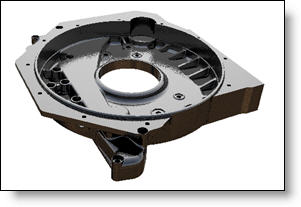
|

|
Light
accuracy with 10% |
Light
accuracy with 100% |
|
|
This parameter
only calculates the indirect rays of the sky. This produces a
smoothed rendering more quickly, but this calculation is approximate.
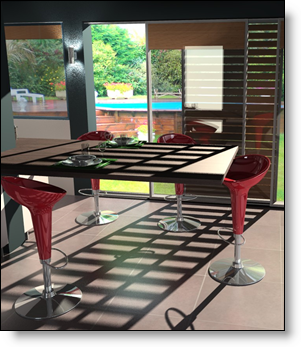
|
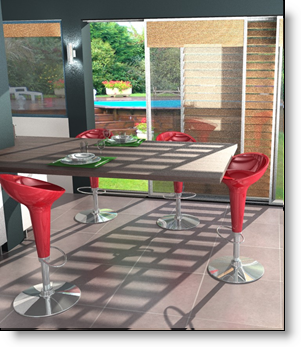
|
Example
of an image computed in the scene with same settings |
Fast
skylight = YES |
Fast
skylight = NO (it takes about 2 more times) |
|
|
This option
allows you to accurately simulate the ambient light reflected
by the scene itself, and no longer only the direct light from
luminous sources.
In a classic image calculation,
an area that is not directly lit by light is black. In reality,
this area receives light re emitted by the walls and scene objects.
Global illumination takes this effect into account and avoids
obtaining unlit areas.
This option is particularly
useful for implementation and architecture images.

|
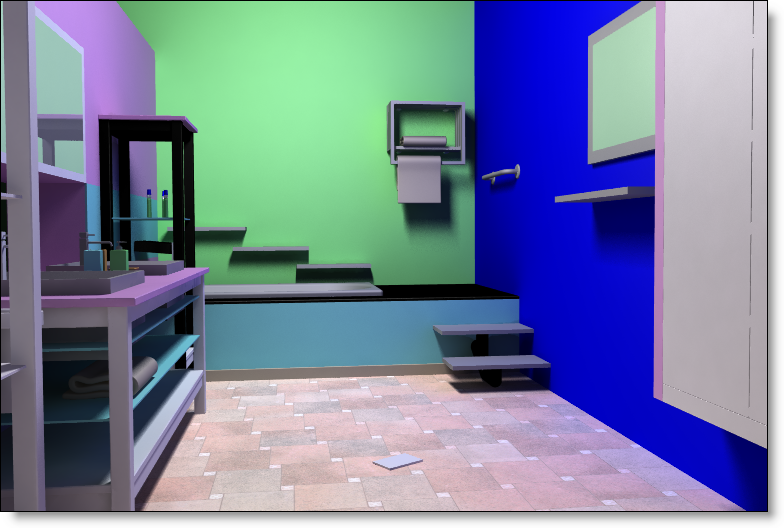
|
Without
global illumination |
With
global illumination |
|
|
By checking
this option this style will be the current style and it will be
used by default in the Realistic
Rendering command.
It will appear in bold in the Styles > Rendering styles folder
of the entities tree.
|
|
Format:
select the extension of the backup file, BMP, PNG, JPEG, TIFF,
Radiance HDR and OpenEXR. Quality:
influences the overall quality of the image (set at 90 by
default). Only available with the format .JPEG
|
|
Recursion
depth: allows to set the
shadow, the reflection and the refraction depths together.
For example, if several mirrors reflect one in the other,
with a value of 1, the shadow will be reflect in only one
mirror. With a value of 2, this reflection can also be reflected
in another mirror. This setting is only for beamed shadows..
Ray
cutoff: when a beam is reflected or refracted, part
of its intensity is lost. When the intensity of a beam goes
under the bottom value, this beam is no longer considered
in the calculation of the image. This setting allows you to
balance the duration and the accuracy of the calculation in
scenes rich in reflection and/or refraction. Volumetric
lighting: indicates if volumetric
lighting effects are to be calculated. Volumetric step length:
precision of the calculation; the new intensity and radii
are calculated at each indicated step length. Volumetric sample count:
number of rays added to the calculation during scattering. Caustics: a caustic
is
the envelope of light rays reflected or refracted by a curved surface or object,
or the projection of that envelope of rays
on another surface.
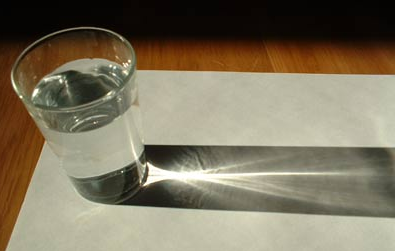
|
Example
of a caustic through a glass of water |
|
Modifications / Additional information:
The style can be modified, deleted, deactivated and made current, from
the Styles folder of the entities
tree.
![]()






